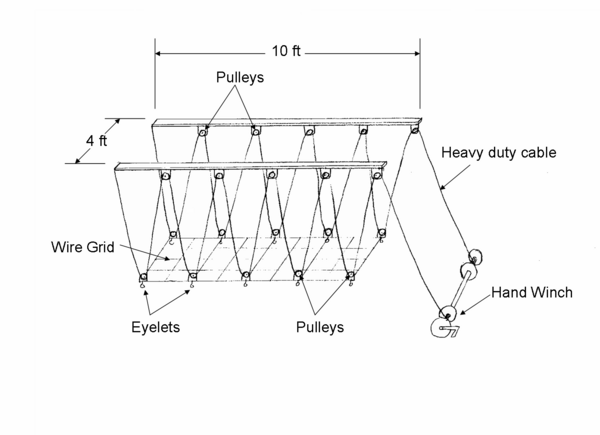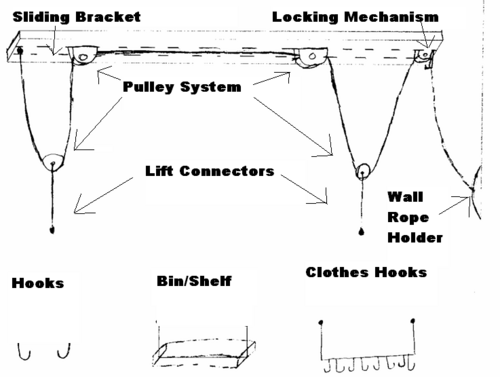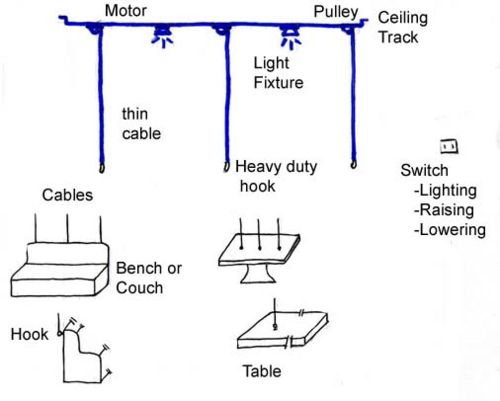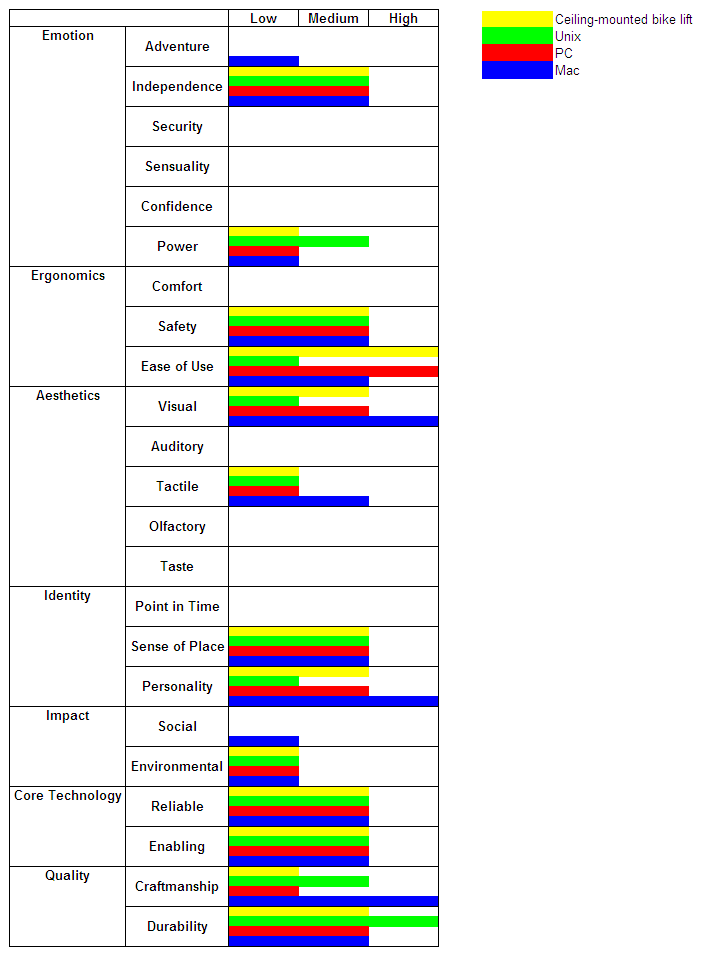Ceiling-mounted bicycle lift redesign
From DDL Wiki
This article was contributed as part of a design project for the course 24-441 Engineering Design in the spring semester of 2007 at Carnegie Mellon University.
Team 1 - Report 1: Ceiling-mounted bicycle lift
Team 1 - Report 3: Ceiling-mounted storage lift
Contents |
Executive Summary
The Ceiling-mounted Bike Lift currently is a well designed and optimized product. However, it is limited to only storing bicycles and we feel that a similar product with more functionality by being able to lift and store other items would be a good addition to your product line. Our research and observations show a need for a product that is capable of storing items that vary in shape, size, and weight in an out of the way location such as the space below a ceiling.
Our top three concepts are the Heavy Duty Industrial Lift, the Garage and Basement Storage Lift, and the Indoor Furniture Lift. The Heavy Duty Industrial Lift is more durable, larger, and capable of storing multiple large items. The Garage and Basement Storage Lift is very similar to the original product, but features interchangeable devices for lifting different items. It also features adjustable brackets to be able to change the length between pulleys to be able to handle an even larger variety of items. The Indoor Furniture Lift offers a fresh new idea of storage by suspending furniture from retractable cables. The furniture may be raised up out of the way or lowered for use. It is designed to be aesthetically pleasing for a household.
We analyzed and compared our concepts and the original bike lift using a Pugh Chart and a Value Opportunity Analysis table. The Pugh Chart considers the criteria of cost, durability, safety, aesthetics, usefulness, and strength. The Heavy Duty Industrial Lift obtained a negative net score while our other two concepts obtained positive net scores indicating that they significantly improve upon the Ceiling-mounted bike lift. The Garage and Basement Storage Lift did not have a negative score in any of the criteria. The Value Opportunity Analysis table did not indicate much difference in the way each product makes the user feel due to the main difference between the products being their intended locations and the items they are capable of storing. The Garage and Basement Storage Lift concept keeps costs low while greatly increasing the funcionality of the original product. Thus, we recommend that the Garage and Basement Storage Lift be the primary concept for future development and prototyping.
Research and Observations
We have been tasked to identify a new opportunity in the domain of the ceiling-mounted bicycle lift and develop new product design recommendations to improve and expand your product line. As we stated in our previous report, we feel that the product has been designed very well and that it fulfills its intent to use the commonly unused space directly below a ceiling for storage. However, this product is severely limited to only being able to store one bicycle. We feel that you will be able to improve and expand your product line by producing new products that can store many other items in the space directly below a ceiling. The Ceiling-mounted bicycle lift research documentation page shows pictures of storage places that we have taken during our research and the results from a survey we have taken to determine what items may be stored by a ceiling mounted device. This research gave us a chance to go beyond our own personal experience of storage problems and see what sort of items that different people could feasibly and usefully store near a ceiling. We found that the possible items varied in shape, size and weight by a significant amount. Popular responses in our survey were sports equipment, clothing, books, and seasonal items. It became evident that there is a need for an innovative storage system capable of holding a variety of items.
Concept Generation
We held a brainstorming session as a group to develop as many storage solutions as possible. Our ideas were focused on using the space below a ceiling for storage. Our list of ideas can be seen on the Ceiling-mounted bicycle lift brainstorming documentation page. We voted on the ideas to narrow them down and develop a few strong concepts. We will describe our top three concepts in detail below. They can be characterized as being analagous to three available computer systems: Unix, a Microsoft Personal Computer (PC), and a Macintosh (Mac). This analogy is based soley upon our opinions and is not an advertisement for any particular system. Unix is capable of doing a lot of things, but is not very pleasing to look at or easy to use; a PC is highly functional and easier to use; a Mac is functional in a smaller range of applications and made to be aesthetically pleasing.
Concept 1: Heavy Duty Industrial Lift (Unix)
The Heavy Duty Industrial Lift takes the idea of the ceiling-mounted bike lift to another level. It would be built with strong and durable materials that could withstand very high loads. It is intended to be used in an industrial setting to store large heavy objects or multiple heavy objects inside a place such as a warehouse, where high ceilings are common. The Heavy Duty Industrial Lift would utilize the typically unused space directly below a high ceiling. Objects may be stacked or placed on top of the wire grid, or they could be hung from the grid or additional eyelets. The pulley system as shown in the sketch would provide a 10 to 1 mechanical advantage. A heavy duty cable runs through each pulley and the grid is raised and lowered by means of a hand winch, which can provide an additional mechanical advantage.
Concept 2: Garage and Basement Storage Lift (The PC)
The garage and basement storage lift expands upon the ceiling mounted bike lift in many ways. The bike lift has a very small market and appeals to bikers only. The garage and basement storage lift expands the market by being able to lift almost anything that one would store in their basement or garage. It allows for this by having a variety of changeable lifting attachments. They include the original hooks, a bin, and a clothing hook rack as can be seen in the picture below. Many more attachments can be conceived and sold separately. Also, the pulleys at the ceiling will be able to slide back and forth along a track and lock in place so that the user can adjust the distance between them as well as their placement on the ceiling. Finally, a better quality rope will be used so that the lift can raise more weight and the locking mechanism will be less likely to cause fraying.
Concept 3: Indoor Furniture Lift (The Mac)
For our third concept, we decided to incorporate an indoor furniture lift. This lift has many capabilities and innovations that have never been seen before. Its most distinguished features include the ability to raise and lower couches, tables, benches, chairs, book shelves, etc. The design is based on the aesthetically pleasing lifting and lighting track.
Similar to a contemporary lighting track, you can install any type of track lighting fixture onto this design; however, you can additionally install our motorized lifting systems. This lifting system operates on a switch that also controls the lights. This allows for the furniture to be raised and lowered as well. The indoor lifting system is heavy duty as well; capable of supporting a fully loaded couch or a table with thanksgiving dinner.
This new concept has several desirable capabilities that the market has not seen before. First, it allows for new, modern living room arrangements. Since TV, sound and movie technology is entering the living room, why not furniture? Also, for a more conventional use, the lift allows the user to clean under furniture without the hassle of moving large pieces of furniture. The motorized lift provides this for the user.
The cables that support the furniture have heavy duty clips connected to them which are to be connected to the eye bolts that are installed into the back of the desired indoor item. This provides a unique capability to the user that is both desirable and functional.
Concept Analysis
We used two tools to analyze and compare our top three concepts with each other and the original ceiling-mounted bike lift. We constructed a Pugh Chart(below) to compare the three designs with respect to six criteria: cost, durability, safety, aesthetics, usefulness, and strength. The net scores on the bottom of the chart indicate that the Unix concept is not a marketable improvement from the original product, but the PC and Mac concepts are improvements. The Unix concept fails mostly due to its projected high cost. The chart shows that the PC concept is an overall improvement on the ceiling mounted bike lift product due to its similar cost, safety and durability and an improved score for usefulness and strength. The Mac concept indicates that it is an improvement in some aspects such as aesthetics and usefulness but a high cost slightly balances it out.
- Please refer to the page Pugh chart for a more detailed description of the purpose and format of a design selection matrix.
In addition to the Pugh chart, we constructed a value opportunity analysis table (see below) for the original product and our top three concepts. As can be seen in the table, all four products tend to evoke the same feelings in the user with the major exceptions in ease of use, visual aesthetics, and personality. The main differences between the concepts is in their intended locations and the items they are capable of storing.
- Please refer to the page VOA for a more detailed description of a value oppurtunity analysis.
Conclusions
Our previous report showed how we believe that the Ceiling-mounted bike lift is a well designed and optimized product. However, we feel that it has a limited market and that you may be able to expand your product line with a similar ceiling mounted storage device that is capable of holding items other than a bicycle. Observation of storage areas and a survey of prospective users indicate the need for such a device. Our top three concepts offer different solutions to the storage problem. The Heavy Duty Industrial Lift (Unix) offers great capability but high cost and poor aesthetics makes it unappealing to be used in a household. The Indoor Furniture Lift (Mac) is a fresh new concept for saving space in a household but again, its higher cost may cancel out some of its good features. The Garage and Basement Storage Lift (PC) keeps costs low while greatly increasing functionality. Thus, the Garage and Basement Storage Lift is our favorite concept and our primary recommendation for further development and prototyping.
Group Members: Jeff Polack, Kevin Pruzinsky, Davey Quinn, Russel Verbofsky







